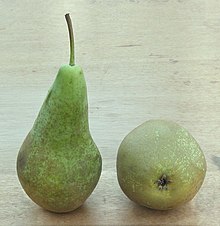Conference (pear)
Conference is a variety of pear ( Pyrus communis ). It was introduced in 1895 by the English breeder Thomas Francis Rivers at the National Pear Conference of the Royal Horticultural Society in Chiswick and was named after them.
The tree is primarily suitable for shaped fruit growing , high trunks and trellises are also possible. The leaves are relatively long and have entire margins. The variety is prone to parthenocarpy , especially when the flowers are poorly pollinated. This means that fruits are set even without cross-pollination. The curtain is usually so large that it is worth thinning out. The variety is recommended for the home garden, in the English plantations it is a main variety. As a diploid variety, it is a good pollen donor . The pollinator variety is Hardy, Harrow Sweet , Früh von Trévoux or Williams Christ Pear , among others .
This variety is not susceptible to scab . Soils rich in limestone lead to chlorosis . The temperature requirements are low, so that an extension is also possible in cooler locations. Leaf damage reminiscent of fire blight or bacterial blight has been observed since the 2000s . In contrast to these diseases, however, only the leaves are browned and dried out. The branch can remain on the tree because the leaf buds remain healthy and the damaged leaves later fall off by themselves, unlike in a fire blight. Long-lasting heat waves are suspected to be the cause, as the phenomenon also occurs when trees are adequately irrigated.
The fruit is medium-sized, 50–60 mm wide, 70–100 mm high, and weighs around 155–200 g. The shape is bottle-shaped, bell-bellied, rounded around the cup, pointed towards the stem and slightly drawn in. Ribs are completely absent. A handle pit is missing. The stalk is 35–45 mm long, thin, thickened towards the base, woody and gradually merges into the fruit. The calyx pit is narrow, flat and regular, often with a bright, rust-free ring around the calyx. The calyx is medium to large, open and brown. The tips are fused at the base, partly erect and rolled lengthways or turned back. The surface is rough and dry. The green base color brightens greenish-yellow. The body color is mostly missing. The points are small, brown, inconspicuous. Characteristic is the fine, brown, often flaky, cohesive around the eye, against the stem is patchy resolution russetting . The calyx tube is bowl-shaped or triangular and small. The core house is medium-sized, spindle-shaped, with a hollow axis. The compartments are medium in size. The seeds are chestnut brown, constricted towards the base, well developed. The yellowish-white flesh, reddened to salmon-colored in the case of fully ripe fruits, is melting, fine, juicy, sweet, with a pleasant spice.
The fruits are ripe for picking from mid-September, then ready for consumption from October. When fully ripe, the pulp quickly becomes doughy; picked a little beforehand, the fruit will keep in normal storage until December. They are suitable for cold or CA storage for several months , after which they ripen well.
See also
literature
- Manfred Fischer (Ed.): Color Atlas of Fruit Types. 2nd, heavily revised edition. Ulmer, Stuttgart 2003, ISBN 3-8001-5547-8 , p. 100.
- Hans Kessler: Pear varieties of Switzerland. Published by the Swiss Fruit Association in Zug. With 40 illustrations in eleven colors, 10 outline drawings and 78 sectional drawings. Verbandsdruckerei AG book publisher, Bern 1948.
- K.-H. Baake: The Organic Gardener - Pear Trees - Varieties (Pyrus communis)
Web links
- Index card of the variety in the BUND-Lemgo fruit variety database
- Conference at the fruit growing consultancy Baden-Württemberg
- Conference variety description , Noah's Ark , PDF, 1.2 MB


